By Rachel Mesch (Regular Contributor)
In October of 1894, a French man by the name of Alfred Dreyfus was arrested for passing confidential documents to Germany. If you are reading this on the Wonders & Marvels page, chances are, you know that part of the story already. (If not, you can review the details here.) But the reason that you know this story is also why it remains relevant today: as a controversy driven by the press. Indeed, the arrest of Dreyfus turned into the Dreyfus Affair because of the media—and because of the French public’s insatiable appetite for news.
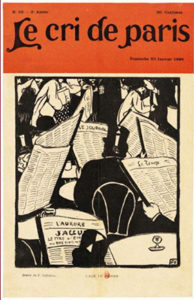
“The Age of Paper”
In late nineteenth-century France, the rapidly developing, technologically advanced mass press had taken root like nowhere else. Fueled by an increasingly literate public, looser laws on freedom of expression, and a competitive marketplace, the number of newspapers multiplied. Circulations skyrocketed from a combined total of one million in 1870 to five million in 1910. Whereas in 1882 there were 3,800 periodicals printed in France, within ten years that already sizable number had tripled.
The proliferation of the mass press had an immediate effect on the French public, especially those in Paris. As historian Vanessa Schwartz has demonstrated, newspapers changed the way that city dwellers related to each other, allowing readers to feel as if they were part of a social community, reading about the same things, interested in the same stories. But this new virtual community also had ways of tearing people apart.
It was in the midst of this subtle yet profound transformation of the urban social fabric that the arrest of Captain Dreyfus became the Dreyfus Affair.
Truth Vs. Hate
As the espionage intrigue unfolded, full of emerging and mostly untruthful details about who gave what to whom and why, a vast web of publications, able to churn out both morning and evening editions (the original “24 hour news cycle”), fed the public’s unquenchable thirst for new information. For those paying close attention, the facts were proven to be on Captain Dreyfus’s side fairly quickly: in 1896 Lieutenant Colonel Georges Picquart, no friend of French Jews himself, discovered the real spy in Captain Esterhazy and provided the evidence to prove it.
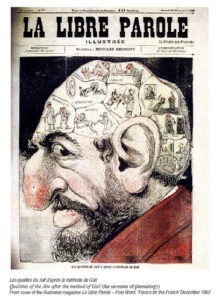
A caricature of the Jewish brain from Drumont’s illustrated weekly.
No matter. Dreyfus would not be exonerated for another ten years.
This was largely because, with the help of the mass press, the Dreyfus Affair pitted facts against feelings, turning marginal flames of hate into a raging anti-Semitic fire.
Guess which side sells more papers?
Before Zola made his voice heard in 1898, most newspapers were feeding the slow-brewing populist rage against the intellectual class, with a special hatred for Jews like Dreyfus who had risen up in French society through the military.
The French Anti-semite-in-chief was Édouard Drumont, who had written the virulent tract La France Juive (Jewish France) in 1886 and followed up by establishing his Antisemitic League. But it wasn’t until he launched his newspaper La Libre Parole (The Free Word) that he had a vehicle in which to serve up hateful stereotypes on the daily.
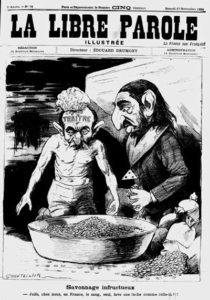
November, 1894. “Fruitless Washing.” “Jews, here in France only blood washes out this kind of stain.”
The Panama scandals of 1892—involving German Jews Jacques Reinach and Cornelius Herz—paved the way for the Affair, showing Jewish involvement in state sanctioned bribery. Drumont’s newspaper offered juicy details installment by installment. In doing so, it created an addicted readership primed for daily controversy. The ingredients for the perfect (media) storm were now at the ready.
After Alfred Dreyfus’s arrest and repeated convictions, La Libre Parole hit its hateful—and self-congratulatory–stride. “Down with Jews” screams one famous headline above an image of Drumont himself. The illustrated version of the newspaper rejoiced in full page meme-like cartoons on its covers. “Frenchmen,” reads one caption from 1894 calling out “Judas Dreyfus.” “I’ve been telling you this every day for eight years!”
While initially anti-Dreyfus sentiments dominated the daily papers, supporters of Dreyfus slowly found their voice, aided ultimately by Emile Zola’s famous accusation—where else but on the front page of a daily newspaper. Zola’s 1898 “J’accuse” was as much an act of typographical genius as a rhetorical one: the bold-faced letters of his plea demanded attention through dramatic visual revolt against the broadsheet itself.
Alternative Facts
With one side deftly fanning the fames of populist rage, the other side continued to insist on the facts of the matter. “You want confessions? Here are some!” declared a poster from 1898, delineating the various testimonies that should have resolved the whole thing.
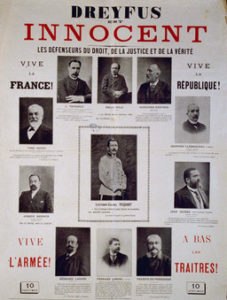
“Dreyfus, An Innocent Man”
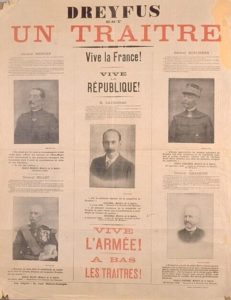
“Dreyfus, A Traitor”
But facts were no match for… alternative facts.
When anti-Dreyfusards created an official looking poster in 1898 declaring Dreyfus a traitor, replete with photographs of government ministers making statements to that effect, Dreyfusards responded precisely in kind.
They produced a mirror image, with their own officials testifying to the captain’s innocence.
And thus the most polarizing controversy of the modern era took its intractable shape, with each side doubling down on their version of the truth. But how to tell the difference, in what must have felt like a brave new journalistic world? How to distinguish between fact and fiction, equalized with the proper fonts and technological flourishes? The camera was a still new technology, especially for newspapers, and readers were inclined to trust its veracity. To call attention to this very problem, in 1899 the newspaper Le Siècle published a series of images entitled “The Lies of Photography.”
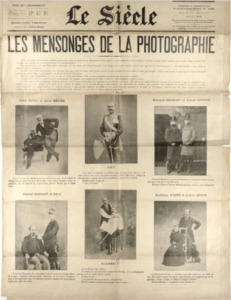
“The Lies of Photography”
In order to demonstrate how easy it was to doctor photographs, they juxtaposed sworn enemies in chummy postures. It was time for the French to learn that the camera does lie sometimes.
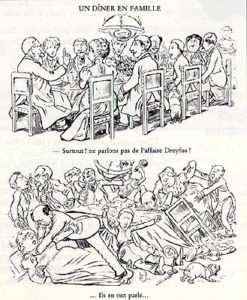
“A Family Dinner” before and after the Affair is mentioned.
So what was the public to do?
Buy more newspapers of course, devour any details to confirm the accuracy of their side, and fly into a blistering rage when faced with the opposition.
A Polarized Society
The media was happy to record this as well. Who doesn’t need a dose of self-deprecating humor in the midst of these maddening debates? Images from newspapers show happy families descending into chaos at the mention of Captain Dreyfus.
Neutrality proved impossible even in the domestic safe space of the breakfast table as husbands and wives retreated to their separate headlines. Bedrooms were torn asunder; togetherness seemed impossible.
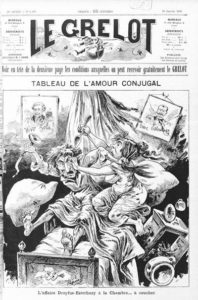
“A Portrait of Conjgual Love,” 1898, with Zola as hero on one side, and Esterhazy denounced on the other.
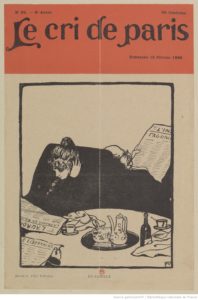 People were no longer talking to each other, no longer meeting each other’s eyes, their interactions mediated exclusively by their choice of media.
People were no longer talking to each other, no longer meeting each other’s eyes, their interactions mediated exclusively by their choice of media.
Truth Wins?
The Dreyfusards were eventually vindicated, with the Captain’s full exoneration coming in 1906. The side of truth had spilled the most ink in the end—through long treatises, full published volumes, and tedious records of the trials and legal proceedings. The facts can be boring, sometimes.
But if truth ultimately won the media war that was the Dreyfus Affair, it was a Pyrrhic victory at best. The anti-Dreyfusards had waged far too many inky battles, in sound bites and caricatures, inflammatory headlines and vile rhetoric, for the public to emerge unscathed.
Further reading:
For more on the extensive visual record of the Dreyfus Affair, see Norman L. Kleeblatt’s edited volume for the Jewish Museum, The Dreyfus Affair. Art, Truth & Justice. Berkeley: U of California Press, 1987.
The Fonds Dreyfus at the Musée d’art et d’histoire du judaisme in Paris has a wonderful collection of over 3,000 objects relating to the Affair, over two-thirds of which are personal items that belonged to the Dreyfus family.
For more on the late nineteenth-century mass press and its impact on Parisian society, see Vanessa Schwartz, Spectacular Realities: Early Mass Culture in Fin-de-Siècle Paris. Berkeley: U of California Press, 1999.
 Rachel Mesch teaches French literature, history, and culture at Yeshiva University in New York. She is the author of Having it All in the Belle Epoque: How French Women’s Magazines Invented the Modern Woman (Stanford UP, 2013) and The Hysteric’s Revenge: French Women Writers at the Fin de Siècle. She is currently at work on a book examining transgender identity in the nineteenth century.
Rachel Mesch teaches French literature, history, and culture at Yeshiva University in New York. She is the author of Having it All in the Belle Epoque: How French Women’s Magazines Invented the Modern Woman (Stanford UP, 2013) and The Hysteric’s Revenge: French Women Writers at the Fin de Siècle. She is currently at work on a book examining transgender identity in the nineteenth century.
